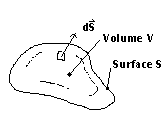
Having introduced our continuum, or hydrodynamic, variables, we now need to construct equations of motion for these variables. We do this by appealing to conservation laws, such as conservation of mass, momentum, and energy. In this section we will focus on the conservation of mass and derive the equation of continuity for the mass density. Consider an arbitrary, fixed volume V, inside the fluid (see Fig. 2.3).

Figure 2.3: Fluid volume used for the derivation
of the continuity equation.
where the minus sign has been added since the mass is decreasing, and the last equality follows from the divergence theorem. Now the total mass in the volume V is
and the rate at which this mass is changing with time is
Since mass is conserved in an arbitrarily small volume V, the integrands of Eqs. (2.1) and (2.3) must be equal, and we have
This is the equation of continuity, which is a mathematical statement of conservation of mass.